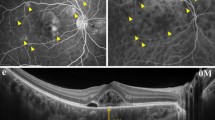Abstract
Purpose
To report a case of bilateral acute posterior multifocal placoid pigment epitheliopathy (APMPPE) evaluated by optical coherence tomography (OCT), fundus autofluorescence (AF) and microperimetry, both in the acute phase and after resolution of symptoms.
Methods
Complete ophthalmological evaluation, including fluorescein angiography, OCT, AF, and microperimetry upon presentation and 1 month later, after lesions have subsided. An attempt to correlate the findings on presentation and changes after resolution is performed using the results of these new investigational techniques.
Results
APMPPE showed hyperreflectance in OCT at the level of the outer retinal layers, without increase in retinal thickness. AF revealed early decreased fluorescence due to a masking effect, and later reveals increased fluorescence after resolution of OCT findings. Function is disturbed at the lesion sites, as shown by microperimetry, and later returns to near normal values on microperimetry.
Conclusion
APMPPE shows outer retinal layers changes on OCT, which resolve totally after subsidence of the acute phase. AF shows areas of increased fluorescence after resolution, with near normal return of function on microperimetry.






Similar content being viewed by others
References
Deutman AF, Oosterhuis JA, Boen-Tan TN, Aan de Kerk AL (1972) Acute posterior multifocal placoid pigment epitheliopathy; pigment epitheliopathy or choriocapillaritis. Br J Ophthalmol 56:863–874
Deutman AF, Lion F (1977) Choriocapillaris nonperfusion in acute multifocal placoid pigment epitheliopathy. Am J Ophthalmol 84:652–657
Dhaliwal RS, Maguire AM, Flower RW, Arribas NP (1993) Acute posterior multifocal placoid pigment epitheliopathy; an indocyanine green angiographic study. Retina 13:317–325
Framme C, Brinkmann R, Birngruber R, Roider J (2002) Autofluorescence imaging after selective RPE laser treatment in macular diseases and clinical outcome: a pilot study. Br J Ophthalmol 86(10):1099–1106
Gass JD (1999) Stereoscopic atlas of macular diseases, 2nd edn. Mosby, St Louis
Young NJA, Bird AC, Sehmi K (1980) Pigment epithelial diseases with abnormal choroidal perfusion. Am J Ophthalmol 90:607–618
Author information
Authors and Affiliations
Corresponding author
Rights and permissions
About this article
Cite this article
Souka, A.A.R., Hillenkamp, J., Gora, F. et al. Correlation between optical coherence tomography and autofluorescence in acute posterior multifocal placoid pigment epitheliopathy. Graefe's Arch Clin Exp Ophthalmo 244, 1219–1223 (2006). https://doi.org/10.1007/s00417-006-0343-1
Received:
Revised:
Accepted:
Published:
Issue Date:
DOI: https://doi.org/10.1007/s00417-006-0343-1




